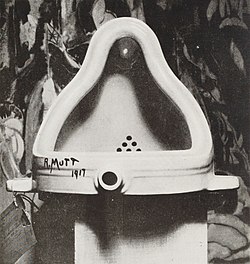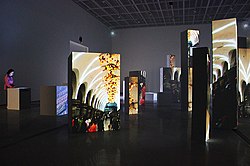Installation art
Installation art is a style of visual art that uses three-dimensional objects. These artworks are usually meant to change the perception of a space (the way a space is seen). Installation artworks can be permanent or temporary and are shown in museums, galleries or in public spaces.
Some of the earliest installation artworks were Marcel Duchamp's readymade objects. However, the real development started in the 1970s. Today, with the improvement of technology, artists use and mix new medias and may involve sensors too in order to make the visitors interact with the installations. +{{{1}}}−{{{2}}}
Gallery
|
Installation Art Media
An installation art of Mad crab created with waste plastics and similar non-biodegradable wastes at Fort Kochi, India.
Visitors interact with a couple in bed, inside one of the many environments of La Menesunda (1965), one of the earliest large-scale installations in art history.
Allan McCollum.The Shapes Project, 2005/06
Guardians of Time, Manfred Kielnhofer, Festival of Lights (Berlin) French Cathedral, Berlin, Velotaxi 2011
Marc Lee 10.000 Moving Cities, 2010-ongoing, National Museum of Modern and Contemporary Art Seoul
An urban interactive art installation by Maurizio Bolognini (Genoa, 2005), which everybody can modify by using a cell phone.
Firoz Mahmud, Sucker'wfp21 aircraft sculptural installation at Aichi Arts Center.
Bibliography
- Bishop, Claire. Installation Art a Critical History. London: Tate, 2005.
- Coulter-Smith, Graham. Deconstructing Installation Art. Online resource
- “Installation.” Oxford English Dictionary. 2006. Oxford English Dictionary Online. 30 January 2006 [1] Archived 2006-06-25 at the Wayback Machine.
- “Install, v.” Oxford English Dictionary. 2006. Oxford English Dictionary Online. 30 January 2006 [2] Archived 2006-06-25 at the Wayback Machine.
- Reiss, Julie H. From Margin to Center: The Spaces of Installation Art. Cambridge, MA: MIT Press, 2001. ISBN 0-262-68134-X
- Rosenthal, Mark. Understanding Installation Art: From Duchamp to Holzer. Munich: Prestel Verlag, 2003. ISBN 3-7913-2984-7
- Suderburg, Erika. Space, Site, Intervention: Situating Installation Art. Minneapolis London: University of Minnesota Press, 2000. ISBN 0-8166-3159-X
- Ferriani, Barbara. Ephemeral Monuments: History and Conservation of Installation Art. Los Angeles: Getty Publications, 2013. ISBN 978-1-60606-134-3













